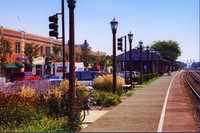Urban Design Strategy Paper
Urban Design Strategy Report Summary
 As the regional population expands, well-conceived urban design principles become more important. Increasingly, planners, developers and municipal administrators are looking to the benefits of compact, easily accessible developments that offer a mix of land uses and transportation options. As part of the following strategy report, CMAP has identified three paradigms that show "good" design principles in practice. Traditional Neighborhood Development (TND) finds its inspiration in the town centers and neighborhoods that were built before the automobile dictated transportation and land use patterns. Transit-Oriented Development (TOD) espouses similar principles to TND, but also incorporates at least one form of public transportation, typically a rail stop. Suburban Retrofit/Greyfield Redevelopments attempt to find new uses for large defunct developments that do not pose the environmental contamination risks of Brownfields (obsolete industrial construction). Shuttered shopping malls are a common cause of Greyfields. If you feel compact, walkable urban design is important to your community, please review the following strategy report. Comments and criticisms are encouraged.
As the regional population expands, well-conceived urban design principles become more important. Increasingly, planners, developers and municipal administrators are looking to the benefits of compact, easily accessible developments that offer a mix of land uses and transportation options. As part of the following strategy report, CMAP has identified three paradigms that show "good" design principles in practice. Traditional Neighborhood Development (TND) finds its inspiration in the town centers and neighborhoods that were built before the automobile dictated transportation and land use patterns. Transit-Oriented Development (TOD) espouses similar principles to TND, but also incorporates at least one form of public transportation, typically a rail stop. Suburban Retrofit/Greyfield Redevelopments attempt to find new uses for large defunct developments that do not pose the environmental contamination risks of Brownfields (obsolete industrial construction). Shuttered shopping malls are a common cause of Greyfields. If you feel compact, walkable urban design is important to your community, please review the following strategy report. Comments and criticisms are encouraged.
A sample of findings:
Primary Transportation Impacts
- Urban design will increase pedestrian trips in the areas where it is applied, by increasing the walkability of a neighborhood
- Urban design will increase access to transit and, by extension, transit ridership. This is because urban design increases the catchment area for pedestrian trips to transit by improving the walking environment. In addition, if urban design is applied around transit facilities (transit oriented development), the increased density means that there are more people with a short radius of the transit facility.
- Because of the above factors, vehicle miles traveled (VMT) will be reduced in areas where urban design is improved
- As noted in the definition, improved urban design usually increases density. Therefore, applying urban design in an area will increase the number of people and jobs that can be accommodated in this area.
- The application of urban design also increases land value. Access to transit increases it even more, but the application of urban design even in the absence of transit facilities increases land value.
|
Links |